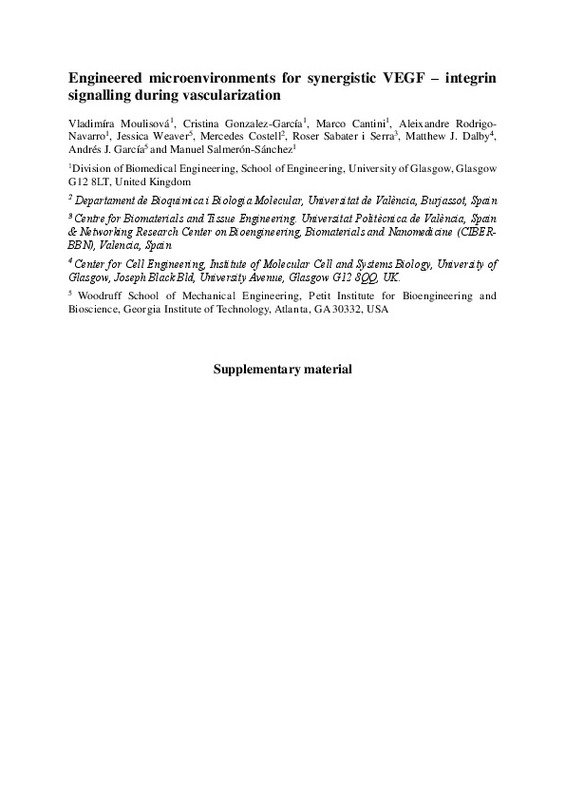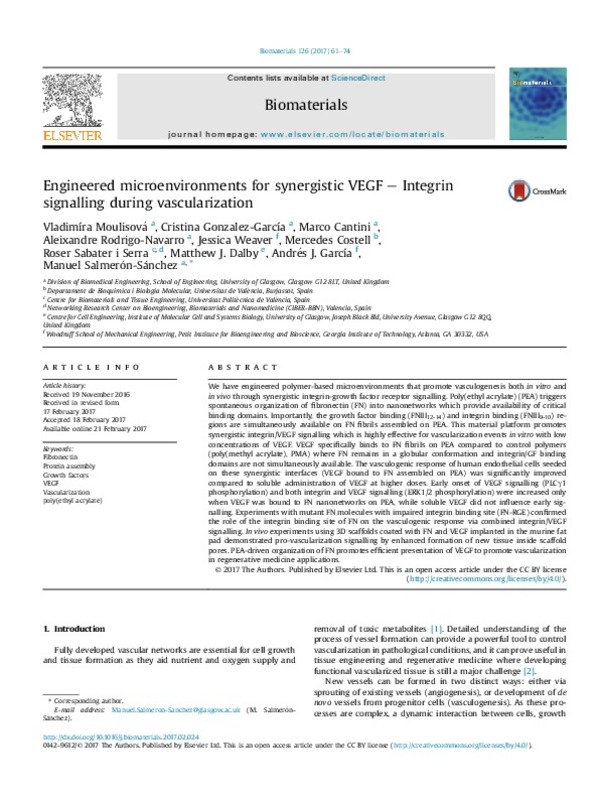JavaScript is disabled for your browser. Some features of this site may not work without it.
Buscar en RiuNet
Listar
Mi cuenta
Estadísticas
Ayuda RiuNet
Admin. UPV
Engineered microenvironments for synergistic VEGF - Integrin signalling during vascularization
Mostrar el registro sencillo del ítem
Ficheros en el ítem
| dc.contributor.author | Moulisova, Vladimira
|
es_ES |
| dc.contributor.author | González García, Cristina
|
es_ES |
| dc.contributor.author | Cantini, Marco
|
es_ES |
| dc.contributor.author | Rodrigo Navarro, Aleixandre
|
es_ES |
| dc.contributor.author | Weaver, Jessica
|
es_ES |
| dc.contributor.author | Costell, Mercedes
|
es_ES |
| dc.contributor.author | Sabater i Serra, Roser
|
es_ES |
| dc.contributor.author | Dalby, Matthew J.
|
es_ES |
| dc.contributor.author | García, Andrés J.
|
es_ES |
| dc.contributor.author | Salmerón Sánchez, Manuel
|
es_ES |
| dc.date.accessioned | 2018-06-08T04:25:57Z | |
| dc.date.available | 2018-06-08T04:25:57Z | |
| dc.date.issued | 2017 | es_ES |
| dc.identifier.issn | 0142-9612 | es_ES |
| dc.identifier.uri | http://hdl.handle.net/10251/103616 | |
| dc.description.abstract | [EN] We have engineered polymer-based microenvironments that promote vasculogenesis both in vitro and in vivo through synergistic integrin-growth factor receptor signalling. Poly(ethyl acrylate) (PEA) triggers spontaneous organization of fibronectin (FN) into nanonetworks which provide availability of critical binding domains. Importantly, the growth factor binding (FNIII12-14) and integrin binding (FNIII9-10) regions are simultaneously available on FN fibrils assembled on PEA. This material platform promotes synergistic integrin/VEGF signalling which is highly effective for vascularization events in vitro with low concentrations of VEGF. VEGF specifically binds to FN fibrils on PEA compared to control polymers (poly(methyl acrylate), PMA) where FN remains in a globular conformation and integrin/GF binding domains are not simultaneously available. The vasculogenic response of human endothelial cells seeded on these synergistic interfaces (VEGF bound to FN assembled on PEA) was significantly improved compared to soluble administration of VEGF at higher doses. Early onset of VEGF signalling (PLC gamma 1 phosphorylation) and both integrin and VEGF signalling (ERK1/2 phosphorylation) were increased only when VEGF was bound to FN nanonetworks on PEA, while soluble VEGF did not influence early signalling. Experiments with mutant FN molecules with impaired integrin binding site (FN-RGE) confirmed the role of the integrin binding site of FN on the vasculogenic response via combined integrin/VEGF signalling. In vivo experiments using 3D scaffolds coated with FN and VEGF implanted in the murine fat pad demonstrated pro-vascularization signalling by enhanced formation of new tissue inside scaffold pores. PEA-driven organization of FN promotes efficient presentation of VEGF to promote vascularization in regenerative medicine applications. | es_ES |
| dc.description.sponsorship | The support from the European Research Council (ERC HealInSynergy, 306990), the UK Medical Research Council (MR/L022710/1) and IOF-Marie Curie fellowship program (Protdel 331655) are acknowledged. RSS and MC acknowledge funding from MINECO-Spain through MAT2015-69315 (including FEDER funds). AJG acknowledges support from the NIH (R01 AR062368 and R01 AR062920). | es_ES |
| dc.language | Inglés | es_ES |
| dc.publisher | Elsevier | es_ES |
| dc.relation.ispartof | Biomaterials | es_ES |
| dc.rights | Reconocimiento (by) | es_ES |
| dc.subject | Fibronectin | es_ES |
| dc.subject | Protein assembly | es_ES |
| dc.subject | Growth factors | es_ES |
| dc.subject | VEGF | es_ES |
| dc.subject | Vascularization | es_ES |
| dc.subject | poly(ethyl acrylate) | es_ES |
| dc.subject.classification | INGENIERIA ELECTRICA | es_ES |
| dc.subject.classification | FISICA APLICADA | es_ES |
| dc.title | Engineered microenvironments for synergistic VEGF - Integrin signalling during vascularization | es_ES |
| dc.type | Artículo | es_ES |
| dc.identifier.doi | 10.1016/j.biomaterials.2017.02.024 | es_ES |
| dc.relation.projectID | info:eu-repo/grantAgreement/MINECO//MAT2015-69315-C3-1-R/ES/SOPORTES CELULARES BIODEGRADABLES CARGADOS CON IONES BIOACTIVOS PARA REGENERACION MUSCULAR/ | es_ES |
| dc.relation.projectID | info:eu-repo/grantAgreement/NIH/NATIONAL INSTITUTE OF ARTHRITIS AND MUSCULOSKELETAL AND SKIN DISEASES/3R01AR062368-03S1/US/ | en_EN |
| dc.relation.projectID | info:eu-repo/grantAgreement/NIH/NATIONAL INSTITUTE OF ARTHRITIS AND MUSCULOSKELETAL AND SKIN DISEASES/4R01AR062920-05/US/ | |
| dc.relation.projectID | info:eu-repo/grantAgreement/EC/FP7/331655/EU/Microfluidics-Generated Hydrogel Particles for Protein Delivery/ | |
| dc.relation.projectID | info:eu-repo/grantAgreement/EC/FP7/306990/EU/Material-driven Fibronectin Fibrillogenesis to Engineer Synergistic Growth Factor Microenvironments/ | |
| dc.relation.projectID | info:eu-repo/grantAgreement/RCUK/MRC/MR/L022710/1/GB/ | |
| dc.rights.accessRights | Abierto | es_ES |
| dc.contributor.affiliation | Universitat Politècnica de València. Departamento de Física Aplicada - Departament de Física Aplicada | es_ES |
| dc.contributor.affiliation | Universitat Politècnica de València. Departamento de Ingeniería Eléctrica - Departament d'Enginyeria Elèctrica | es_ES |
| dc.description.bibliographicCitation | Moulisova, V.; González García, C.; Cantini, M.; Rodrigo Navarro, A.; Weaver, J.; Costell, M.; Sabater I Serra, R.... (2017). Engineered microenvironments for synergistic VEGF - Integrin signalling during vascularization. Biomaterials. 126:61-74. https://doi.org/10.1016/j.biomaterials.2017.02.024 | es_ES |
| dc.description.accrualMethod | S | es_ES |
| dc.relation.publisherversion | https://doi.org/10.1016/j.biomaterials.2017.02.024 | es_ES |
| dc.description.upvformatpinicio | 61 | es_ES |
| dc.description.upvformatpfin | 74 | es_ES |
| dc.type.version | info:eu-repo/semantics/publishedVersion | es_ES |
| dc.description.volume | 126 | es_ES |
| dc.identifier.pmid | 28279265 | en_EN |
| dc.identifier.pmcid | PMC5354119 | en_EN |
| dc.relation.pasarela | S\351110 | es_ES |
| dc.contributor.funder | Ministerio de Economía, Industria y Competitividad | es_ES |









